Dog Enrichment: What Does It Mean?
As all dog owners know, ensuring your dog is living their happiest and healthiest life is your main priority. Putting this into practice, you must consider all areas of your dog’s lifestyle including enrichment. Canine enrichment is defined as the ways in which you engage your dog in activities and environments which stimulate their mind, keep them physically active and support their emotional wellbeing. By making sure your dog has a sufficient amount of enrichment in their daily life, you are on your way to giving them the best life possible.
For those unfamiliar with dog enrichment, there are many factors to consider when it comes to deciding what forms of enrichment are best for your dog. Although this idea may seem daunting at first, we are here to help you streamline the process and ensure that you are equipped with the knowledge and tools to give your dog an enjoyable and enriching life.
What does enrichment do for a dog?
Enrichment comes in many different forms, all of which are essential for your dogs mental and physical wellbeing, Enrichment activities can help to improve your dog’s cognitive abilities, encourage positive behaviours, reduce anxiety, build confidence and create deeper bonds. Keep reading to discover even more benefits enrichment can bring to your dog’s life.
What are the six types of enrichment?
In total there are six different types of enrichment that are considered to be essential to your dog leading a happy life; these are, physical, cognitive, social, nutritional, occupational and sensory. All of these types of enrichment work in combination with one another to mentally stimulate your dog and create a more complex and enriching life. Below, we’ll break down the benefits and examples of the ways in which each type of enrichment can be given to your dog.
Physical dog enrichment
Physical enrichment doesn’t refer to just walking your dog, it includes any physical element that gives your dog an outlet for the positive expression of naturally occurring behaviours. Physical enrichment should ensure you are consistently engaging in play with your loyal companion such as fetch and tug of war, introducing new environments to your daily walks and encouraging natural hunting behaviours to help give them the physical stimulation they need.
Physical enrichment also includes altering the quality and complexity of your dog’s living space, such as rotating their toys regularly to prevent boredom, upgrading their sleeping space and adding new comfort elements to their surroundings. Physical enrichment has a direct impact on your dog’s mental health, the more varied physical engagement they have, the happier their life will be.
Cognitive dog enrichment
This type of enrichment focuses on mental stimulation, encouraging your dog to use their brain through problem-solving activities such as puzzles, learning new tricks and behavioural training. These activities are not only a great way to challenge your dog’s abilities but are also very valuable at keeping their brains active which can aid in slowing down age-related cognitive decline. Cognitive enrichment can also be beneficial at correcting any unwanted behavioural issues as it prevents boredom and can also help with reducing anxiety. Some examples of cognitive canine enrichment include;
- Food puzzles or interactive feeders
- Training exercises or agility training
- Teaching new tricks or obedience cues
- Introduce new dog toys
- Develop predatory hunting skills through games like hide and seek.
Social canine enrichment
Dogs are social creatures just like us, meaning that it is essential for our dogs to have social interaction with other furry friends to boost their overall wellbeing and bring joy to their life. Regular social enrichment helps your dog to develop good behaviours and relationships with other dogs and humans as well as helping to reduce fearfulness and overexcitement in social situations. One of the easiest ways to bring social enrichment to your dog’s life is to take them to your local park or walking route where they can play and interact with other friendly dogs, or alternatively, if you have friends with dogs too, set up a doggy play date for your canines.
Another great way to encourage social interaction, especially from a young age, is with training classes, as they get to interact with other dogs whilst also learning positive behaviours. Similarly, doggy day-care or organised local group dog walks are also helpful in ensuring your dog gets a healthy level of social interaction with both dogs and humans regularly.
Nutritional dog enrichment
Nutritional enrichment can also be referred to as feeding enrichment. This type of enrichment encourages dogs to engage in natural scavenging behaviours using food and treats as rewards. Allowing space for your dog to engage in these natural behaviours not only adds a fun additional activity to their day but can also help to improve their physical condition. Encouraging foraging behaviours that include scent and search practices to locate food is a great way to mentally stimulate your dog and keep their brains active. There are many ways you can encourage nutritional dog enrichment such as:
- Dog puzzles
- Snuffle mats such as Lickimats
- Stuffable dog toys and Treat dispensing toys such as those from KONG
- Hiding treats around the house
Occupational canine enrichment
Occupational enrichment refers to the ways in which you can challenge your dog or give them a “job” to do, which is an especially important type of enrichment for working dog breeds. Research has shown that occupational enrichment helps to keep dogs mentally stimulated and is also a great way for them to release excess energy. Types of occupational enrichment include anything that encourages your dog to use problem-solving skills, this can range from something as simple as training your dog to play fetch to becoming a service dog for those in need. Examples of occupational enrichment include:
- Dog agility courses
- Obedience and trick training
- Puzzle dog toys that make them work for food
- Playing fetch or any other form of interactive play
- Dog tracking and detection
- Sheepherding
- Emotional support dog training
- Service dog training and service.
Sensory dog enrichment
We all know that a dog’s sense of smell is their strongest sense and stimulating your dog’s senses can play a large part in canine enrichment. Sensory enrichment is all about stimulating the different senses of dogs, the five senses being, sight (visual), sound (auditory), touch (kinesthetic), smell (olfactory) and taste (gustatory). There are many ways to stimulate your dog’s senses which can be beneficial for their mental, physical and emotional health as well as aiding in reducing anxiety in stressed dogs.
Visual Stimulation
This refers to dog’s being able to see inside and outside of their environments including both static and moving images. Visually stimulating objects placed outside of your dog’s immediate environment can help to provide interest, for example, allowing your dog to see out of the window to people watch can help provide entertainment. Another example of visual stimulation is allowing your dog to be able to see out of their kennel, as this helps provide them with comfort in an otherwise isolated environment.
Auditory Stimulation
Stimulating your dog’s auditory senses includes things such as, playing music or putting the radio on, this helps to buffer any noise of kennel environments or mimic familiar noises they would usually hear when everyone is home, providing comfort and calmness when home alone. Studies have shown that classical music can help reduce stress levels in dogs, increase rest and improve sleep. However it is important to note that whatever auditory stimulation you choose should not be constant, must be kept to a low volume and something that is pleasing to your dog, not just the caretakers’ preferences.
Kinesthetic Stimulation
This type of stimulation for dogs can be practised in many different ways, from showing affection through petting to engaging in predatory play and playing with treat-dispensing toys. It is in your dog’s natural instincts to engage in predation such as, searching, stalking, chasing and fighting, you can help stimulate these instincts by using toys to mimic prey when interacting with your dog. Dogs may also choose to fight with other dogs, this is another natural kinesthetic stimulation behaviour that is sometimes used to assert dominance but can also be used as a form of play too.
Olfactory Stimulation
With scent being your dog’s most prominent sense, ensuring your dog has a variety of activities to stimulate this is important in encouraging dog’s natural behaviours and can also be used to help reduce stress. Activities such as nosework and scent games with treats help to garner your dog’s interest and reduce any potential stress. Calming scents such as valerian and lavender have been proven to have a calming effect on dog’s and reduce the amount of barking. Using a calming plug-in diffuser or spray is a simple way to put this into practice.
Gustatory Stimulation
Providing your dog with a variety of tastes is a great way to keep them mentally stimulated and engaged. While varying their regular food is not advisable, giving them a range of different treats adds variety to their diet and training rewards. Make sure that the foods you’re giving are dog-safe, some of the most popular choices are, any meat-flavoured jerky, hot dogs, chicken, ground beef and peanut butter. Whether you choose to give it by hand or hide it inside of a toy, your dog’s taste buds are guaranteed to be stimulated.
How often do dogs need enrichment?
Dogs should get at least 30 minutes of active stimulation each day, this refers to enrichment activities and excludes their daily walks. It is advised that dogs spend 50% of their day sleeping, 30% relaxing or ‘lazing around’ and the other 20% should be spent engaging in activities such as walking, training, playing, socialising or any other enriching activity. Although 20% may seem daunting for those who spend most of their day working, there are many ways you can give your dog enrichment without you needing to be present. By investing in dog puzzles, interactive feeding mats and treat-dispensing toys, you can keep your dog entertained, mentally stimulated and provide enrichment easily.
What foods are dog safe for enrichment?
As previously discussed, gustatory stimulation (taste) is one way to enrich your dog’s life. When combined with an occupational enrichment activity such as a treat dispensing toy or interactive food mat, you are providing your dog with a tasty, mentally stimulating and satisfying activity. However, you must make sure to always use dog safe foods to fill toys and treat-dispensers with, these foods include:
- Chicken, beef and salmon
- Peanut butter and plain yoghurt
- Bananas, apples, blueberries and watermelon
- Broccoli, carrots, green beans and avocado
- Sweet potato, pumpkin and chickpeas.
Here at Direct4Pet we stock a wide variety of dog food, dog treats and dog toys perfect for helping you along with canine enrichment.
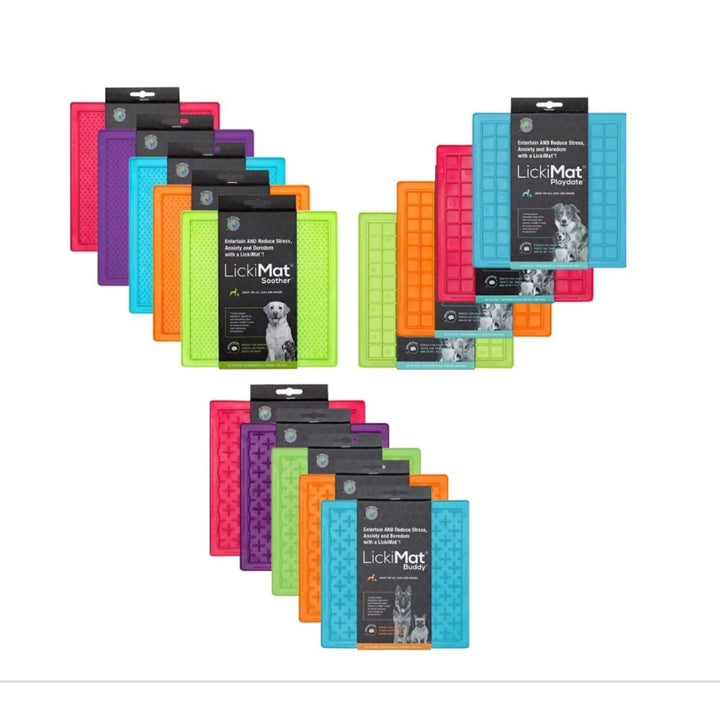
Lickimat Playdate Treat Interactive Mat Boredom Buster £7.69
LickiMat® is known for their collection of unique and innovative pet products designed by vets for all breeds, ages and sizes of dogs and cats. Designed to provide pets with an enriching, fun and stimulating experience, Lickimats have many benefits including, reducing anxiety, tackling boredom, making food last longer and keeping pets occupied for greater lengths of time. These specific Playdate™ Lickimats have unique grooves and discrete pockets to hold food and create a challenging feeding experience for your pet. Fill with a mixture of food textures and tastes to give your dog an enriching, mentally stimulating treat or fun meal time. Available in a variety of colours, shapes and designs to suit you, shop all Lickimats here at Direct4Pet to find the perfect enrichment tool for your pup.
Similar to a Lickimat, this Company Of Animals Slow Feeder is great for not only providing an enriching activity for your dog but is also highly beneficial for preventing digestive issues, slowing down fast-eaters and is great for overweight dogs. Simply load up this feeder with your dog’s usual meal and turn a simple feeding time into a fun game.
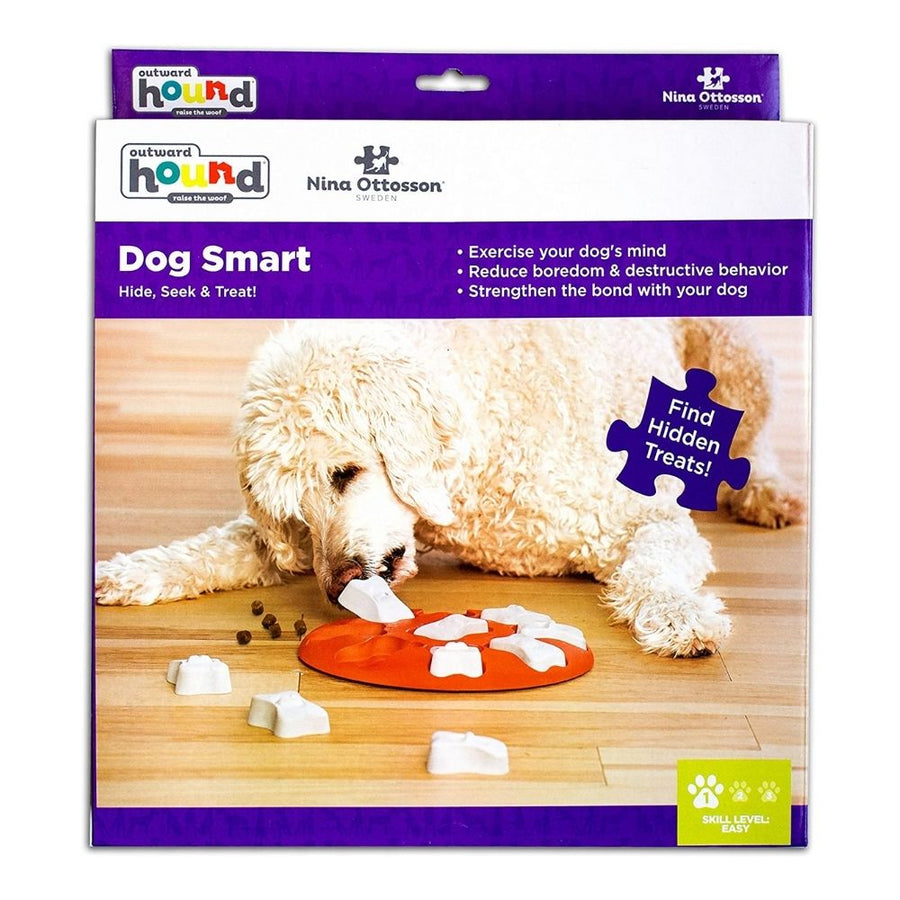
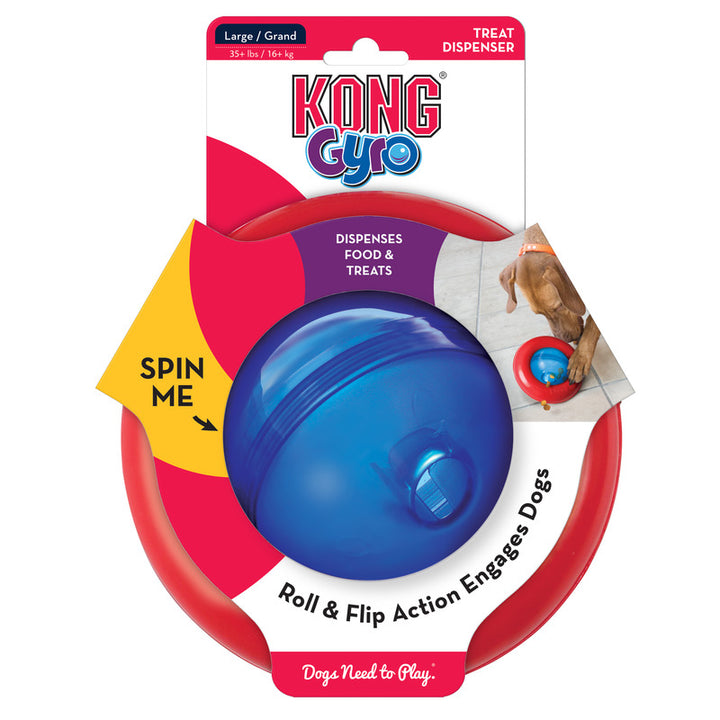
Nina Ottosson by Outward Hound Dog Smart Orange Interactive Treat Puzzle Dog Toy £12.09 and KONG Gyro £12.29
If you’re looking for an enriching activity to keep your dog occupied for a long length of time, this Nina Ottosson Interactive Treat Puzzle is ideal. Suitable for any breed or size, this puzzle is great for challenging pups of all ages. Featuring nine hidden compartments that can be filled with your dog’s favourite treats and then covered by removable dog bone shaped pieces. Using their sense of smell, dog’s will nudge and paw at the bones to get to the hidden treat, creating an engaging, mentally stimulating and fun activity that helps to reduce boredom and prevent destructive behaviours.
For dog’s that love play time, level up their toys with the KONG Gyro. Combining the fun of play with the reward of a tasty treat, the KONG Gyro is a great toy for enriching your dog’s day and extending play. With an irresistible roll and flip action, a centre spinning orb and static outerring, this toy encourages dogs to push, paw and roll this ball until it dispenses whatever tasty treat you decide to place inside. Browse through the full collection of KONG dog toys for more enriching activities for your pup.
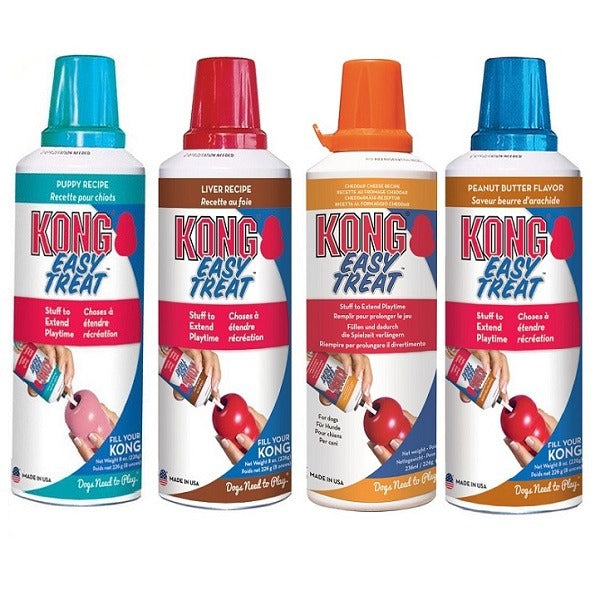
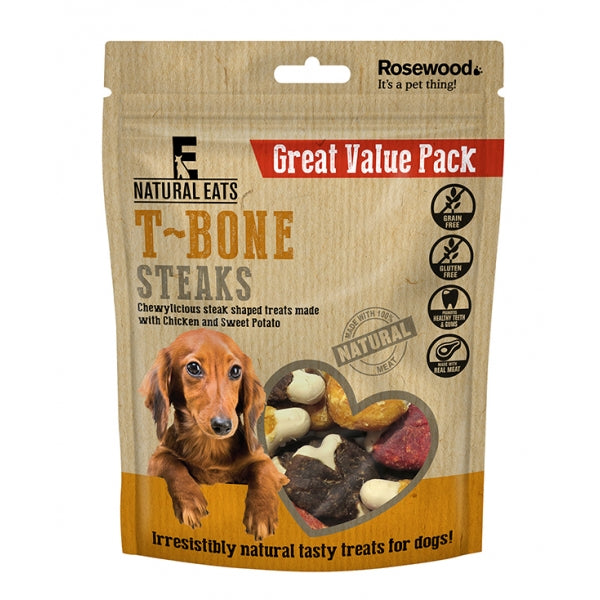
KONG Easy Treat £9.19 and Natural Eats T-Bone Steak Dog Treats £7.79
Designed to help you easily fill treat-dispensing toys or interactive feeding mats, the KONG Easy Treat comes in a variety of delicious, irresistible flavours including liver and peanut butter to help engage and delight your dog. In an easy-to-use can, this treat paste can be easily dispensed into any treat dispensing toy from KONG or other brands to help reward your dog or extend play time. Made from highly-digestible, trans-fat free ingredients are specially formulated for all dogs from 8 weeks old to seniors.
Ideal for training, rewarding and interactive play, these Natural Eats T-Bone Steak Dog Treats contain 100% real meat, are naturally grain and gluten free and are designed to not only enrich your dog’s taste buds but also promote healthy teeth and gums. Whether you use these treats as training rewards or as part of an enriching play time activity, your dog is sure to feel satisfied with these delicious and nutritious treats.
